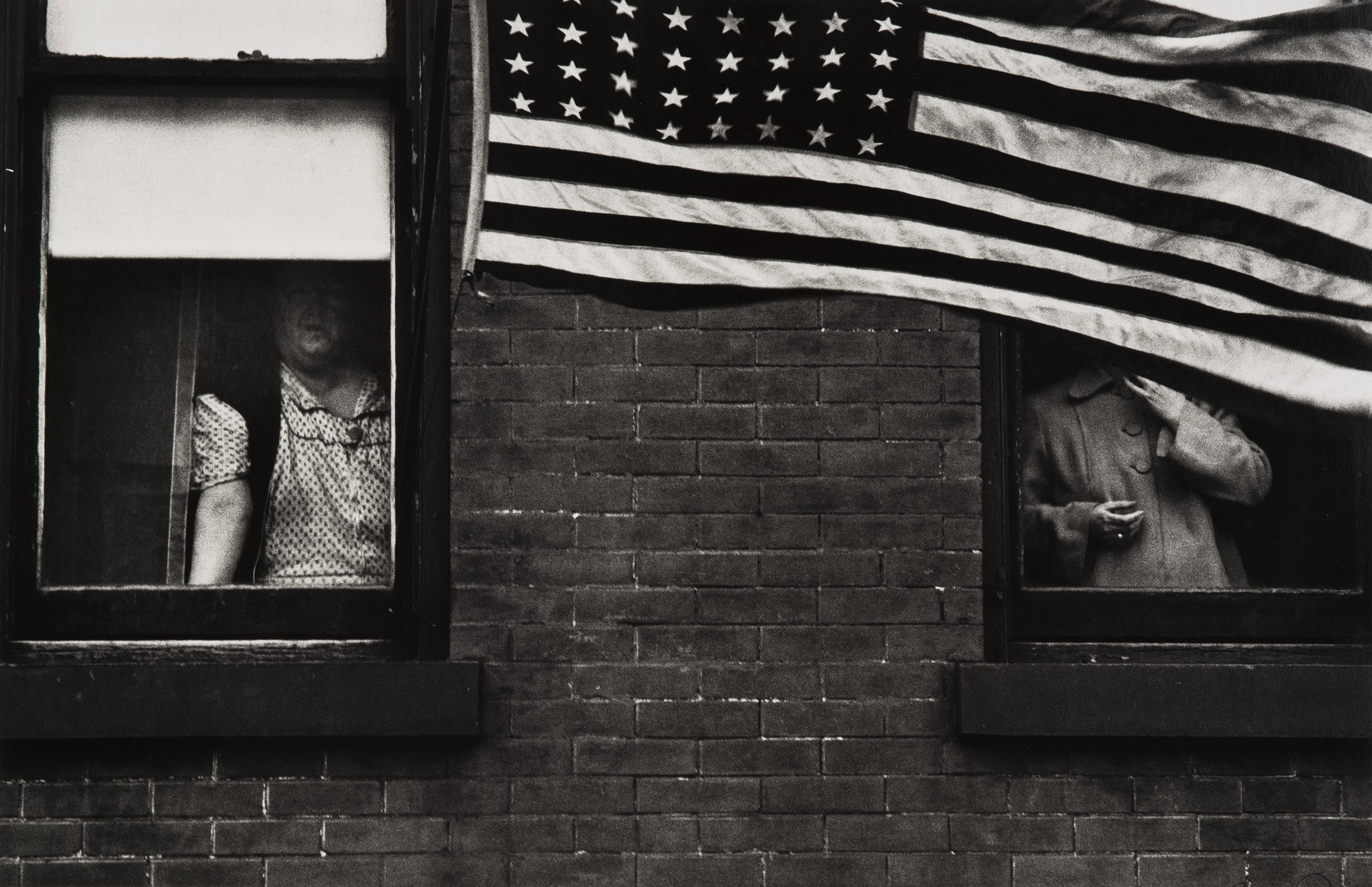

Photographs from the Collection of Robert Richardson and Monona Wali
17
Robert Frank
Parade – Hoboken, New Jersey
1955
Gelatin silver print, printed later.
8 1/2 x 13 in. (21.6 x 33 cm)
Signed, dated and annotated 'Hoboken, N. J.' in ink in the margin.
Full-Cataloguing
Parade – Hoboken, New Jersey is the first plate in The Americans. As such, it sets the tone for the book in which the American flag and the pageantry of politics are recurring themes set alongside Frank’s critique of a country enjoying post-war prosperity but also divided by racial and class divisions. Throughout 1956 and 1957 Frank developed and printed the thousands of pictures he had taken across the country since 1955, and slowly honed in on the sequence that would ultimately be published. The Americans is meticulously sequenced, made up of discreet passages, each beginning with an image of an American flag. Parade – Hoboken, New Jersey serves as an ideal overture to the images that follow, all of which relate to each other within a scrupulously orchestrated progression.
The book’s depiction of America was initially misunderstood and loudly criticized. Frank’s intent was far more complex and nuanced, and his images more deeply layered, than reviewers initially gave him credit for. Of these images he wrote, 'I have been frequently accused of deliberately twisting subject matter to my point of view. Above all, I know that life for a photographer cannot be a matter of indifference. Opinion often consists of a kind of criticism. But criticism can come out of love' (U. S. Camera Annual, 1958).
The choice selection of images from Robert Frank’s The Americans offered here as lots 13 through 18 all come from the collection of Robert Richardson and Monona Wali. These were acquired from the photographer in the late 1980s and early 1990s. Mr. Richardson is a three-time Academy Award winning cinematographer who has worked with such acclaimed directors as Martin Scorsese, Quentin Tarantino, Oliver Stone, and Errol Morris. In 2019 he received the prestigious Lifetime Achievement Award from The American Society of Cinematographers. Ms. Wali is an award-winning writer, filmmaker, and teacher. Their collection began in the 1980s with acquisitions of work by Frank, Henri Cartier-Bresson, Robert Adams, Edward Weston, Tina Modotti, Danny Lyon, and many others – all images that synthesized the then-married couple’s dual interests in photography’s visual and narrative power.
Mr. Richardson writes, 'Robert Frank’s work was my teacher in so many ways. He taught me with his precise vision how to look upon an America that others could not, or would not, or were unable to see. His career was not simply one book, The Americans, although many hold that up as perhaps the finest of his work, and the finest of anyone’s. But his later images and films with his family brought out the emotional heart of what he captured through his lens as he grew older and wiser. Many call him a documentary photographer. I see that perspective, but I also see vastly more. I see and feel the subjective point of view of a master – in my mind, the master.'
The book’s depiction of America was initially misunderstood and loudly criticized. Frank’s intent was far more complex and nuanced, and his images more deeply layered, than reviewers initially gave him credit for. Of these images he wrote, 'I have been frequently accused of deliberately twisting subject matter to my point of view. Above all, I know that life for a photographer cannot be a matter of indifference. Opinion often consists of a kind of criticism. But criticism can come out of love' (U. S. Camera Annual, 1958).
The choice selection of images from Robert Frank’s The Americans offered here as lots 13 through 18 all come from the collection of Robert Richardson and Monona Wali. These were acquired from the photographer in the late 1980s and early 1990s. Mr. Richardson is a three-time Academy Award winning cinematographer who has worked with such acclaimed directors as Martin Scorsese, Quentin Tarantino, Oliver Stone, and Errol Morris. In 2019 he received the prestigious Lifetime Achievement Award from The American Society of Cinematographers. Ms. Wali is an award-winning writer, filmmaker, and teacher. Their collection began in the 1980s with acquisitions of work by Frank, Henri Cartier-Bresson, Robert Adams, Edward Weston, Tina Modotti, Danny Lyon, and many others – all images that synthesized the then-married couple’s dual interests in photography’s visual and narrative power.
Mr. Richardson writes, 'Robert Frank’s work was my teacher in so many ways. He taught me with his precise vision how to look upon an America that others could not, or would not, or were unable to see. His career was not simply one book, The Americans, although many hold that up as perhaps the finest of his work, and the finest of anyone’s. But his later images and films with his family brought out the emotional heart of what he captured through his lens as he grew older and wiser. Many call him a documentary photographer. I see that perspective, but I also see vastly more. I see and feel the subjective point of view of a master – in my mind, the master.'
Robert Frank
Swiss | 1924As one of the leading visionaries of mid-century American photography, Robert Frank has created an indelible body of work, rich in insight and poignant in foresight. In his famed series The Americans, Frank travelled the United States, capturing the parade of characters, hierarchies and imbalances that conveyed his view of the great American social landscape.
Frank broke the mold of what was considered successful documentary photography with his "snapshot aesthetic." It is Frank's portrayal of the United States through grit and grain that once brought his work to the apex of criticism, but has now come to define the art of documentary photography.